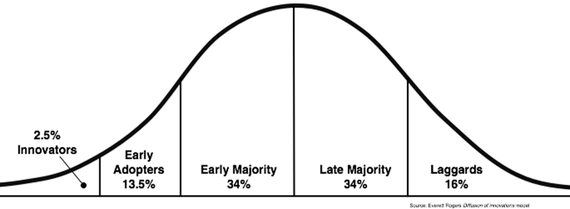Understanding the Process and Need for Change
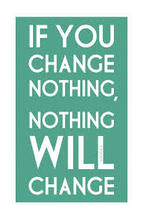
The tire goes flat and we change it. The light bulb burns out and we change (replace) it. We change our clothes for weather, events or hygienic reasons. We change our tone or our word choice depending on who we are speaking to. Change happens every day. We change for obvious reasons and subtle reasons too. Yet, as much as we experience change for all the right reasons, big changes make us uncomfortable and may even scare us. Change forces us to examine our own beliefs and practices and alter what we "normally" do. It is based on the belief that something better exists or can be done more effectively. For some, that leads to the perception that what they are doing now is of poor quality or wrong. While that may be true, it more likely means that even though what they are doing may be good, it could be better. And if it's already great, then we are compelled to ask, how can we continue to be great?
Progress is Impossible Without Change. This concept keeps us relevant in the face of a changing landscape. The needs of consumers (in education that translates to students, educators, parents, etc.) continues to evolve as society changes, as technology progresses, and as our demographics change. When one piece of the puzzle changes, it creates a ripple effect that causes other parts to change. So one either adjusts and keeps moving, or stands still and gets run over, or at least passed by. Schools and districts are being asked to change on the fly without having the benefit of a factory shut down to retool. But in order to ensure that the education our students are receiving is relevant and prepares them to be successful adults, schools must change how we teach and what we teach. It's hard to know where to start with the rapid evolution of current educational trends, but the main thing is to focus on what's best for kids and keep moving forward.
Progress is Impossible Without Change. This concept keeps us relevant in the face of a changing landscape. The needs of consumers (in education that translates to students, educators, parents, etc.) continues to evolve as society changes, as technology progresses, and as our demographics change. When one piece of the puzzle changes, it creates a ripple effect that causes other parts to change. So one either adjusts and keeps moving, or stands still and gets run over, or at least passed by. Schools and districts are being asked to change on the fly without having the benefit of a factory shut down to retool. But in order to ensure that the education our students are receiving is relevant and prepares them to be successful adults, schools must change how we teach and what we teach. It's hard to know where to start with the rapid evolution of current educational trends, but the main thing is to focus on what's best for kids and keep moving forward.
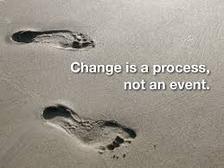
Change is a Process, Not and Event. There is no magic switch to flip or program that will make all the necessary changes happen over night. Change is messy. Meaningful change requires a change of heart, a change in beliefs or attitudes, and a change in practice. Change is an action, but may require patience and always requires perseverance. Change that is purposeful has more impact than random change. Many change models exist that help leaders plan and support the change process. Each of those models also addresses how change is perceived and implemented by those working within the change process. This awareness is a critical piece of the puzzle. Determining what the right change process to use will depend on why the change is needed, the change initiative(s) that are to be implemented, who will be implementing them and how soon those changes must be in place. Effective professional learning will provide the framework to ensure that stakeholders receive the instruction, feedback and support that is needed to implement and sustain the desired change(s).

Focus All of Your Energy on Building the New. Begin with the WHY. Too often we get caught in the negativity that change presents because we don't know or understand WHY the change is needed. It is hard for us to get on to the important things of HOW this change will occur and WHAT the result will be as long as the WHY question is unanswered. Once the WHY has been established, then the process of initiating, implementing, and sustaining the change can begin. It is important to note that while the history of where we've been provides context and lessons learned, it is necessary that we turn our eyes forward and focus on what's in front of us as opposed to what is behind us if progress is to be made. Read More about the Why, How, What
Types of Change
Sometimes change seems rather painless and is just what we do on a regular basis as we deal with new situations. Other types of change challenges us and stirs us emotionally. What is viewed by one person as a significant change is viewed by another as just routine. Perceptions of those involved in the change influence how the change must be initiated, and ultimately whether or not sustained implementation will take place. Change the culture to transform the system. When viewing the following, consider that non of these are mutually exclusive, and in fact have their own merit in terms of implementing change. The key is to understand the "WHY" behind both the need for change and the strategies selected to implement the desired change(s), all of which are focused on the end result.
|
Technical vs. Adaptive Change
Technical change is manageable. It uses the knowledge and skills currently available and uses them strategically, or in a different way. It does not require a change in purpose or beliefs, but does alter behavior or action in some way, usually in the form of a schedule or procedure adjustment. There is typically one correct answer to resolve the given problem, and it can be determined by an authority figure. There is usually general agreement by those involved because it fits within current and accepted norms. Adaptive change is transforming in nature because it requires that one learn new skills or strategies while examining current practices, beliefs, and attitudes. As a result, changing one's belief system or philosophy is uncomfortable as we gain new understandings. This process is "messier" and involves input and investment from the stakeholders. It cannot be done by an authoritative figure. When these philosophical changes occur (the hearts and minds of stakeholders) then the system can be transformed. Read More on Technical and Adaptive Change... And a second article.... |
First Order vs. Second Order Change
First Order change may feel less painful because it is consistent with our current thinking, values, beliefs, and skills. Stakeholders agree on the change as it is planned out and are comfortable with the necessary skills. There is a natural draw to simplify all problem and solve them with one right answer or intervention. Is this where we fall into the proverbial trap of being able to flip a switch? These are often short term solutions and do not transform the system because there has been no successful effort to change the beliefs and the culture. Second Order Change. When new skills, attitudes, approaches, or strategies are required during the change process we call this second order change because it requires more of us than a quick fix. This conflict between what we've always done and believed to be true (or good) and what the change is asking us to do, can cause stakeholders to feel additional stress, incompetence, or discomfort, but also results in the greatest transformation. These second order changes are deeply rooted and take time to evolve during the change process. Read More on First & Second Order Change.... |
Change Models and Processes
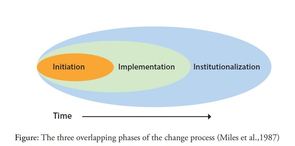
No matter what Change Model is best suited or selected for implementing the desired change, all have common elements. There is an acknowledgement of the reluctance to change that exists, at least initially, until the "Why" is understood and the necessary knowledge and skills are acquired. The recognition of Adult Learning Theory is also present to ensure that new learning or training is done in meaningful ways for all stakeholders. There is awareness of the learning curve or implementation dip so that stakeholders understand the typical pattern of learning how to do something new or in a different way. Lastly, and perhaps most importantly, all models recognize the important role that perception, motivation, and emotions play in terms of the time and effort it will take to get people on board and moving forward. These factors also determine whether the initial reluctance turns into resistance or acceptance.
Several change models are discussed briefly below. More models and processes can be found by clicking on this link or the button at the top of the page.
Michael Fullan's Triple I Model shows us the change process evolving, beginning with initiation (putting the people, skills, strategies, tools and resources in place to make the change happen); followed by implementation that is supported with time (to plan and practice), feedback, and opportunities for revision; and finally by achieving systemic change through institutionalization.
Read More...
Fullan has also published many books on leading change that may be valuable tools for leaders. A summary review of Fullan's Six Secrets of Change can be found here, or in this article by Scholastic.
Everett Rogers's research (Diffusion of Innovations) shows us how new ideas spread through cultures (diffusion). He focused on what factors influence this movement of ideas (innovation, communication, time and social systems). Additionally, he noted that innovation was determined by 5 factors: knowledge, persuasion, decision, implementation and confirmation. Finally he identified behaviors of stakeholders in the change process and how their attitudes, beliefs and behaviors would affect the success of fully implementing the desired changes. This ranged from early adopters to laggards (see figure below). Additionally he identified some intrinsic factors that affected innovation in terms of how difficult, useful, or compatible the innovation was perceived, how much practice implementing was allowed, and how visible the new innovation would be to others.
Read More...
Several change models are discussed briefly below. More models and processes can be found by clicking on this link or the button at the top of the page.
Michael Fullan's Triple I Model shows us the change process evolving, beginning with initiation (putting the people, skills, strategies, tools and resources in place to make the change happen); followed by implementation that is supported with time (to plan and practice), feedback, and opportunities for revision; and finally by achieving systemic change through institutionalization.
Read More...
Fullan has also published many books on leading change that may be valuable tools for leaders. A summary review of Fullan's Six Secrets of Change can be found here, or in this article by Scholastic.
Everett Rogers's research (Diffusion of Innovations) shows us how new ideas spread through cultures (diffusion). He focused on what factors influence this movement of ideas (innovation, communication, time and social systems). Additionally, he noted that innovation was determined by 5 factors: knowledge, persuasion, decision, implementation and confirmation. Finally he identified behaviors of stakeholders in the change process and how their attitudes, beliefs and behaviors would affect the success of fully implementing the desired changes. This ranged from early adopters to laggards (see figure below). Additionally he identified some intrinsic factors that affected innovation in terms of how difficult, useful, or compatible the innovation was perceived, how much practice implementing was allowed, and how visible the new innovation would be to others.
Read More...
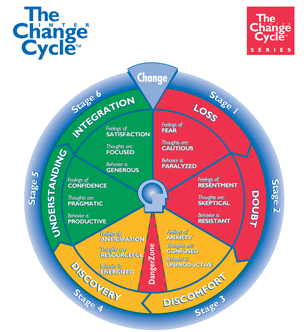
The Change Cycle
People react and respond to change in 6 predictable ways according to the model developed by Lillie Brock and Ann Salerno, co-founders of the Change Cycle (TM) Series. These 6 stages occur in a cycle, reflecting the emotional thoughts, feelings, and behaviors of the person experiencing the change. The 6 stages are: Loss, Doubt, Discomfort, Discovery, Understanding and Integration. When individuals understand and recognize what they are experiencing as they go through the change process, it will allow them to better manage their responses to the change(s). Read More... |
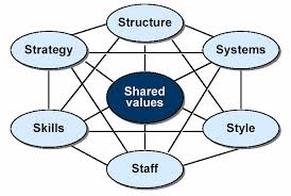
McKinsey's 7-S Model
This change model, first introduced in the late 1970's by Peters and Waterman in their book, In Search of Excellence, focuses on interrelated factors that influence an organization's ability to change. To improve efficiency, these components were viewed as interactive, rather than separate entities in some sort of a hierarchy. This idea sparked discussion about the need for a coordinated effort between parts of an organization, which led to improved communication and collaboration, particularly as it related to implementation of change. Some thirty years later, this model still serves as an important framework to help inform decision making by providing insight into how to efficiently and effectively manage complex systems. The 7 S's are: Style, Skills, Systems, Strategy, Structure, Staff, and Shared Values. All interact around Shared Values which drives the organization. Read More.... |
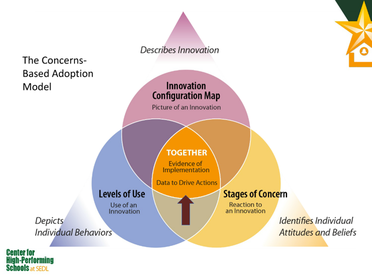
Concerns-Based Adoption Model (CBAM)
This framework, developed at the University of Texas in Austin, deals largely with the feelings, perceptions, and behaviors of those experiencing the change that is to be implemented. CBAM consists of 3 components (dimensions): Stages of Concern, Level of Use, and Innovation Configurations. This framework can be useful in the planning of change, by examining the level of readiness in the educational environment, or during the change process to monitor implementation, report findings, or determine interventions.
Read More...
This framework, developed at the University of Texas in Austin, deals largely with the feelings, perceptions, and behaviors of those experiencing the change that is to be implemented. CBAM consists of 3 components (dimensions): Stages of Concern, Level of Use, and Innovation Configurations. This framework can be useful in the planning of change, by examining the level of readiness in the educational environment, or during the change process to monitor implementation, report findings, or determine interventions.
Read More...
Kotter's 8 Step Process for Leading Change
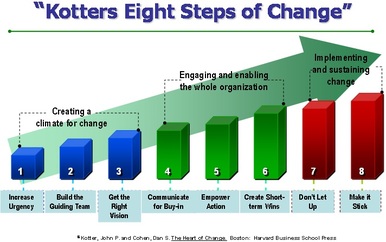
Dr. John Kotter has identified an 8 step process to lead and implement organizational change through his research and observation of practices and subsequent results. He believes that consistency of the process during change will lead to better results. For those who prefer a blue print, this might be a change model that appeals to you most.
Read more.
Read more.

